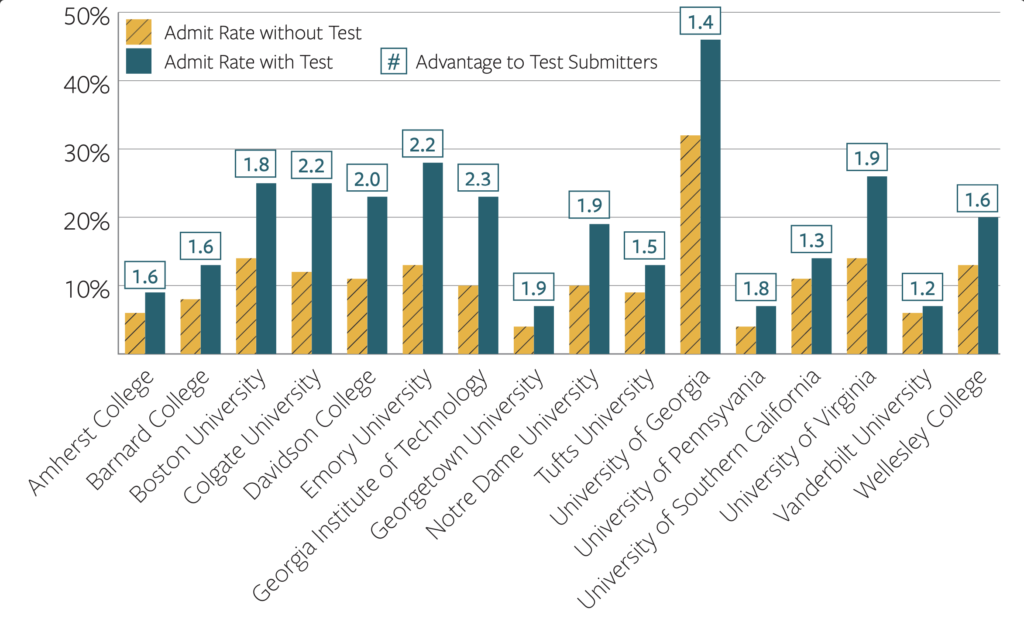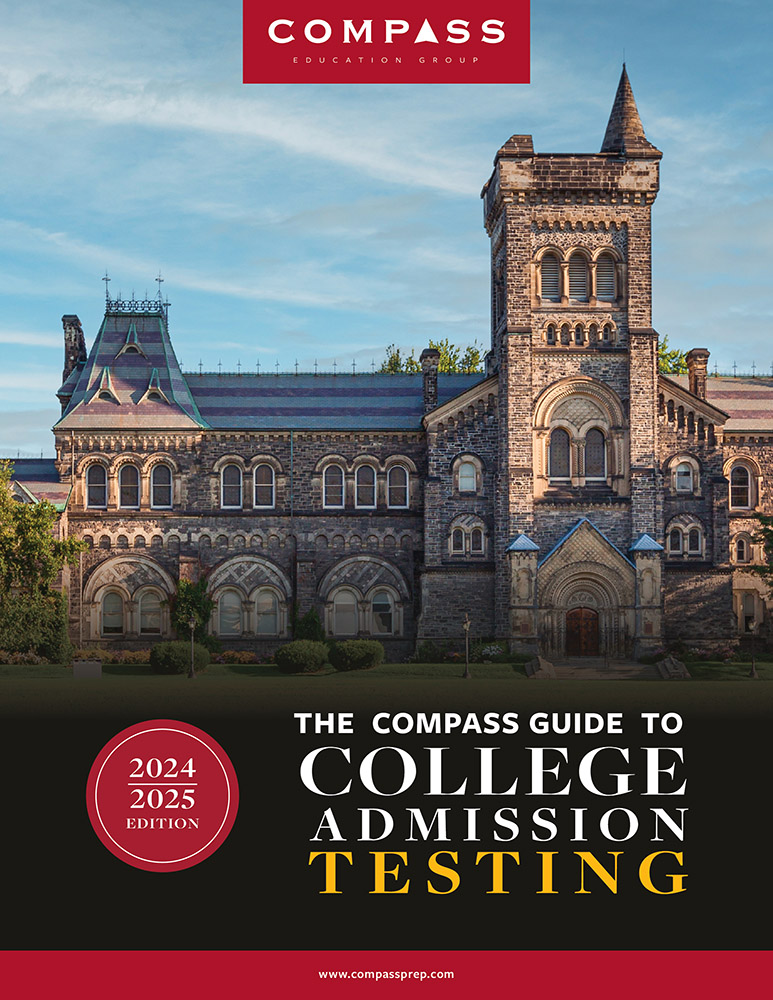 This article is an excerpt from the Compass Guide to College Admission Testing. To download the complete Guide or to request a hard copy, visit compassprep.com/guide.
This article is an excerpt from the Compass Guide to College Admission Testing. To download the complete Guide or to request a hard copy, visit compassprep.com/guide.
Until recently, taking the ACT or SAT was something college-bound students generally considered obligatory, knowing that most four-year colleges and universities would require a standardized test score. Even as the number of test optional schools slowly climbed over time, the safer route had traditionally been to preserve one’s unconditional eligibility by securing official scores.
The pandemic upended testing policy across the college admission landscape and accelerated the loosening of testing requirements, at least temporarily. Over 95% of selective four-year colleges and universities currently let students decide whether to have scores considered or not. And at some institutions, like the UCs, the CSUs, Cal Tech, Dickinson, and Reed, test scores are not even reviewed during the admissions process, although they can sometimes be used for placement and to satisfy certain core requirements.
Pre-pandemic testing policy breakdown for the 400+ schools Compass tracks:
Current testing policy breakdown for the 400+ schools Compass tracks:
Test Optional trial lengths are relative to the 2020–21 admissions cycle. Schools in the one-year trial category intended to only be test optional for the class of 2021, and have yet to provide an updated policy. Schools in the multiyear trial category began their temporary test optional trials with the class of 2021.
Keeping Options Open
With the decision now shifted largely to applicants, it is important to understand what to do with this theoretical advantage. For many students in the class of 2021, the option to apply without scores was not so much a choice as a necessity, having reached their senior year without a chance to fulfill their testing plans. But thanks to the collective foresight of most colleges and universities, last year’s applicants did not find their possibilities much constrained by not submitting test scores; the absence of scores was not a conspicuous omission in the midst of a pandemic. Widespread test site closures meant ACTs and SATs taken nationally were down about 30% in 2020 (down more in some areas), and this resulted in a corresponding drop in applications submitted with scores. Colleges reviewed a lot more applications without test scores this past year and plenty of students enrolled at selective colleges this fall without having produced (or revealed) an ACT or SAT score.
Classes of 2022 & 2023: Testing Will Rebound, And A Score Can Be A Plus
In 2020, most colleges appropriately assumed that an applicant with no test scores did not have safe, readily available opportunities to test before their application was due. Whereas in prior years at test-optional colleges there may have been speculation that uncompetitive scores were being concealed, the class of 2021 got more of the benefit of the doubt.
As testing opportunities improve, an increasing number of selective colleges will expect – and will receive – scores from most applicants. Instead of focusing on what they can forgo, students planning to apply to competitive colleges should consider what others with similar opportunities are apt to present as strengths. Like all discretionary qualities volunteered in an application, scores remain a valuable piece of the holistic review process at many schools, especially those where demand for admission drastically outstrips supply.
All things being equal, applicants who have scores to report retain a potential advantage over those who sit out testing from the start. Therefore, the most prudent path is to err on the side of obtaining strong scores, if feasible. Having the option to send scores—to all colleges, to some colleges, or to no colleges—is when a student’s decision-making opportunity will be optimized.
We’ve already seen that a relaxed testing policy does not make a highly selective school less competitive; in fact it can boost a college’s popularity, increasing the imbalance of available spots and demand for them. Colleges that were already sought after reached record high levels of interest in 2020, especially in their early application rounds, resulting in record low early admit rates. Even more sobering have been figures like those reported by UPenn, which had an early admit rate among score submitters that was nearly twice as high (18.4%) as that of those who did not submit scores (9.5%). While such a statistic causes consternation, it is an extreme case that should not be imputed to the broader field. What can be assumed is that those who chose to submit scores, on average, had some of the strongest overall applications. So while the presence of scores may correlate to higher admission rates at some schools, it can’t be said that sending scores will automatically lead to better outcomes.
Moreover, students who are disadvantaged or discouraged by testing will have more possibilities than ever before, as the option to withhold scores will remain common for the class of 2022 and beyond. In fact, many highly selective schools such as Amherst, Boston College, Colgate, Columbia, Cornell, Harvard, Rice, UVA, and Williams have confirmed that they are retaining test choice policies at least through the 2021-2022 admission cycle.
Parsing Test Optional Policies
As these policy extensions are announced, however, appraise the wording of them for additional insight into a school’s motive and attitude toward testing. Statements released by a number of popular schools like the ones listed above contain notably consistent themes, such as:
- The decision to continue suspending the testing requirement is due to the pandemic;
- The suspension is — for now — temporary;
- Those who are able to obtain ACT/SAT scores are welcome to submit them;
- Those who have test scores from other standardized exams may submit those;
- This policy has contributed to a significant increase in applications.
There is a mistaken tendency to treat all colleges the same. It’s easy to think that general statements about how “colleges act” hold true everywhere when, of course, they do not. It may be helpful, therefore, to place any given 4-year college into one of three general test-policy contexts:
- Still Important
The smallest collection of colleges (accounting for about 1% of 4-year enrollment) receives outsized attention and spurs some of the cynicism and anxiety around the college admissions process. These colleges are exceedingly popular and therefore have admit rates at or below 10%. Nearly every applicant is qualified; nearly every applicant is denied. Test optional policies, if anything, have lowered admission rates further. Applicants must provide a strong case for admission. Students can choose to demonstrate a strength in testing or choose to blend in with other non-submitters. As the data below show, finding a way to stand out can still provide an advantage. - Plus Factor
A much larger set of colleges (accounting for about 19% of 4-year enrollment) has an average admission rate that is still competitive but far more reasonable. Supply and demand imbalances still necessitate a difficult and careful selection process but applications are read supportively. Test scores have traditionally mattered but not more than a sustained track record of academic achievement. Strong test scores can be a plus factor but not a singular difference maker. - Lower Priority
In terms of total enrollment numbers (the remaining ~ 80%), the third pool is by far the largest and consists of colleges that accept the majority of their applicants and evaluate applications based largely on a binary assessment of whether a student has shown the capability to succeed at their institution, or not. Admission decisions don’t hinge on small differences in test scores and it appears that testing will only further diminish in importance at these schools moving forward. However, these schools have established baseline standards and some will even maintain cut-scores as criteria for certain monetary awards or placement decisions.
Test Optional Outcomes
The following is a sampling of statistics from the 2020 admissions cycle at several well-known colleges with competitive admissions. Only a limited number of schools have shared this level of detail from their class of 2021 applicants. While far from exhaustive, this group offers a glimpse into the additive role test scores and submission decisions played in the most competitive contexts. The figures imply a greater likelihood of admission for applicants with test scores versus those without. This apparent edge gained by test scores is reflected in the graph above.
The figures imply a greater likelihood of admission for applicants with test scores versus those without. This apparent edge gained by test scores is reflected in the graph above.
The highest-scoring applicants often tend to have other advantages, including structural privileges such as high SES, level of parental educational attainment, and so on. This societal reality reflected in test scores is the whitehot center of the firestorm over whether tests should be required, optional, or eliminated. For now, the college admission world is broadly settling on the middle ground position.
| College | Score Submit Rate | Admit Rate With Scores | Admit Rate Without Scores |
| Amherst College | 51% | 9% | 6% |
| Barnard College | 41% | 13% | 8% |
| Boston University | 42% | 25% | 14% |
| Colgate University | 41% | 25% | 12% |
| Davidson College | 50% | 23% | 11% |
| Emory University | 50% | 28% | 13% |
| Georgia Institute of Technology | 63% | 23% | 10% |
| Georgetown University | 81% | 7% | 4% |
| Notre Dame University | 51% | 19% | 10% |
| University of Pennsylvania | 61% | 7% | 4% |
| Tufts University | 50% | 13% | 9% |
| University of Georgia | 50% | 46% | 32% |
| University of Southern California | 49% | 14% | 11% |
| University of Virginia | 58% | 26% | 14% |
| Vanderbilt University | 56% | 7% | 6% |
| Wellesley College | 40% | 20% | 13% |
The data above combines results from early and regular rounds.
Compass carefully monitors and reports out on test-taking behavior and the use of scores. The table above offers only a snapshot of different test optional scenarios last year. Visit our college profiles blog post for the most updated compilation of this data for 400+ schools, and reach out to a Compass Director to discuss how these variables shape your testing plans.




Hi Bruce,
It seems that your point is that it is still advantageous for most students to test and to test as many times as you can stand it, rather than not to test at all. And it is really not “optional” for most.
Emily,
I think it is advantageous to have the option to either submit a test score or not. To reserve that benefit, a student of course needs to obtain a score. My situational advice for any individual might vary, but I’m generally in favor of keeping options in play as long as possible, especially when navigating a continuously shifting admissions landscape. The decision to share a score with any given college can wait, so long as you proceed along a sensible testing path.
As for that path, I don’t endorse the more-is-better approach. I find that when students make good use of practice tests and carefully evaluate their results, there is rarely a need to take an official exam more than twice. Some of our students achieve their scoring goal on their first attempt while some others will test three times. Planning for two sittings is pretty typical when a student is well prepared.
Finally, testing indeed is “optional” for most, as more students than ever are entering college without having taken an ACT or SAT. However, some colleges and universities attract an exceedingly high number of applicants. Most applicants are capable of succeeding at these schools — nearly all seem strong “on paper” — and yet most are denied. As I shared in the article, there were examples last year where the admission rate at such schools was considerably higher for those who submitted scores. Although score submitters tend to present some of the very strongest overall applications, I believe that high test scores added value in many of those instances.
Thanks for reading the article and for your comment.